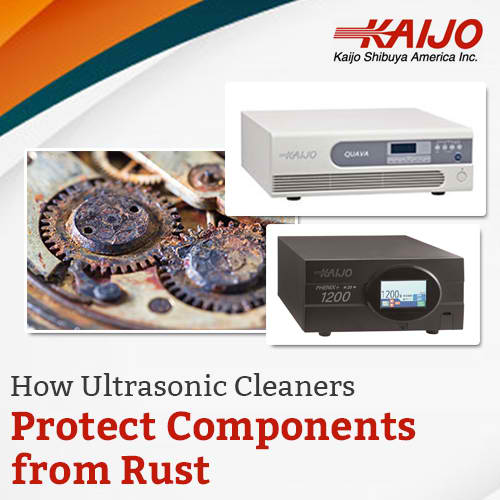How Ultrasonic Cleaners Protect Components from Rust
December 20, 2019
 Metal components can suffer from rust and corrosion unless they are specially protected. Even stainless steel can deteriorate if the outer layer of chromium oxide is disrupted. Metal finishing processes such as passivation help prevent corrosion by increasing the thickness of the protective oxide layer and making sure it is continuous.
Metal components can suffer from rust and corrosion unless they are specially protected. Even stainless steel can deteriorate if the outer layer of chromium oxide is disrupted. Metal finishing processes such as passivation help prevent corrosion by increasing the thickness of the protective oxide layer and making sure it is continuous.
In order for metal finishing to be effective, the metal parts have to be completely clean before the process is applied. Industrial ultrasonic cleaners remove impurities and contamination from metal part surfaces to allow finishing to produce a seamless oxide layer. If a part is not completely clean, the oxide layer may have gaps and rust can attack the part through the holes.
How Passivation Protects Stainless Steel Parts
The addition of small amounts of chromium to steel produces stainless steel that is resistant to rust. The chromium forms a thin layer of chromium oxide on the surface of the stainless steel parts and this layer does not allow oxygen from the air to attack the iron of the steel. When the stainless steel part is cast, machined or formed during fabrication, the manufacturing process can disrupt the layer of chromium oxide and allow the part to rust.
During passivation the stainless steel part is immersed in a solution of citric or nitric acid. The solution increases the thickness of the chromium oxide layer by leaching out some of the iron near the part surface. Less iron near the surface means more chromium and a thicker protective layer. For the passivation process to be effective, the part surface must be completely free from contamination.
Sources of contamination include dust in a workshop environment and the manufacturing process itself. When a part is cut or machined, the tools may leave small iron particles on the part. Oil and grease are other common contaminants. When not removed, they prevent the passivation process from producing a seamless layer of thicker oxide.
Ultrasonic Cleaning Removes Contaminants Quickly and Completely
Industrial ultrasonic cleaners use high-frequency sound waves in a water bath to dislodge particles and contamination from the surfaces of metal parts. The transducers of the ultrasonic cleaning system are immersed in the bath and produce the sound waves in the liquid. The ultrasonic sound waves create microscopic cavitation bubbles that deliver a scrubbing action when in contact with the part surface. Dirt, oil and grease are easily removed.
When contaminants are present, they can keep the passivation acid away from the surface of the part and prevent the thicker layer of chromium oxide from forming. Some heavy contaminants may change the chemistry of the solution and cause the acid to discolor or etch the part. If the metal part is not completely clean, passivation may still allow some surface areas may to rust and may damage the part itself.
The cavitation bubbles from the ultrasonic cleaners are formed throughout the bath, penetrating wherever there is liquid. They remove contamination from parts with complex shapes, grooves in part surfaces, dead end crevices and threaded holes. Instead of using conventional washing methods that involve manual labor, operators can simply place the parts to be cleaned in the ultrasonic bath and remove clean parts ten to twenty minutes later. Even hard-to-reach places are completely free of contamination and subsequent passivation can act to produce a well-protected part.
Kaijo Can Help Protect Components from Rust
Kaijo’s extensive experience with industrial ultrasonic cleaning equipment allows the company to offer free consulting to help customers select the right systems and options. This includes selecting the right frequencies, power and configuration best suited for a specific application. Once it is clear what kind of ultrasonic cleaner is needed, Kaijo can offer solutions from their complete line of ultrasonic cleaning systems and components.





